The flight from Lima to Iquitos took just under two hours. When we arrived we had the luxury of exiting our plane down stairs directly onto the concourse rather than walking through a tunnel. The only way I can describe the exit is analogous to the first bitter cold winter day in MN. When we walked outside we were immediately choked, not by frozen dry air, but by thick heat and humidity. There were rumors of jungle climate but this was our first realization that it really existed.
We grabbed our backpacks and quickly had a bidding war with 5+ taxi drivers, managing to get our 10km ride for 5 soles.
This was also my first realization that this town is absolutely absurd. Being that Iquitos is isolated from the rest of Peru in the Amazon, the only way in or out is by plane or river. With that, there’s very little need for cars, and so the main mode of transportation is motorcycle. It’s a loud little town (actually a big town with a population of 500,000), but it feels small because everyone drives a motorcycle of some sort. The most popular motorcycle is a three-wheeled Honda with a chariot-style seat that can fit three behind the driver. These things are everywhere. They call these tuk tuks (usually seen in Thailand/SE Asia), and you can get a short ride for 2 soles, but it also depends on your negotiation skills too.
 This was also when I realized there are no rules in Iquitos. Besides blowing red lights, no seat belts, no real lanes, and the ability to bribe the police for 10 soles, the most hysterical thing I saw was a family of five on one standard motorcycle. Or another time I saw a family of four on one bike, a woman holding onto her husband with two children in her lap as she breastfed one of them. Safety isn’t the number one concern here obviously.
This was also when I realized there are no rules in Iquitos. Besides blowing red lights, no seat belts, no real lanes, and the ability to bribe the police for 10 soles, the most hysterical thing I saw was a family of five on one standard motorcycle. Or another time I saw a family of four on one bike, a woman holding onto her husband with two children in her lap as she breastfed one of them. Safety isn’t the number one concern here obviously.
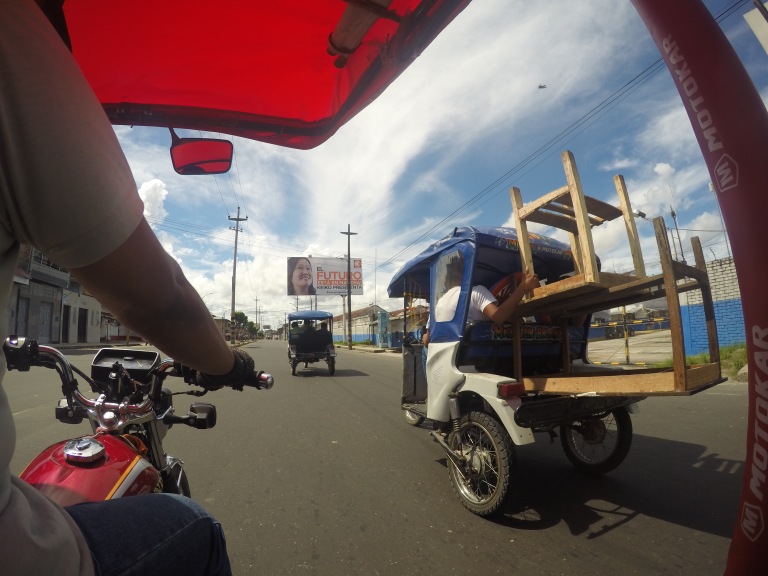 There was room at the Flying Dog hostel (a chain throughout Peru), so we grabbed a room and threw our backpacks down and found some other travelers to hangout with. Someone heard of a bar in town that had live music so we had some drinks and went there.
There was room at the Flying Dog hostel (a chain throughout Peru), so we grabbed a room and threw our backpacks down and found some other travelers to hangout with. Someone heard of a bar in town that had live music so we had some drinks and went there.
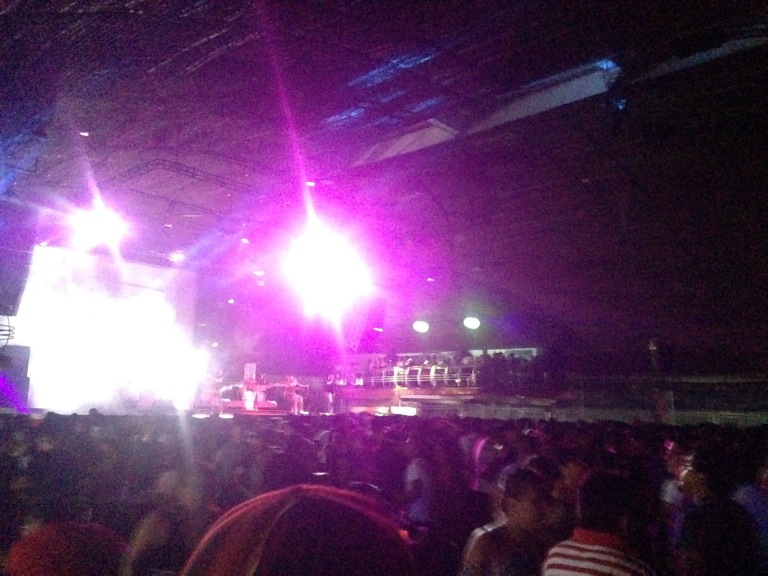
The bar was the kind of spot that the music would screech to a halt of white people walked in.. but just a little larger. So luckily we only got funny looks and the party went on. After a couple hours through, we all tired out and went back to the hostel.
The next day Art, a Danish guy named Søren, and myself went looking for some jungle toury stuff. We went to port named bellavista and found a boat that would take us to an island that had a butterfly house and animal orphanage.


The boats here are called aquatic buses as they’re elongated and can fit tons of people in bus-style seating. From the port we buzzed around the Amazon River for 20 minutes before being dropped at the island.
We jumped out and signed up for a quick tour of the place. It was pretty interesting to see all of the animals you expect to see in the Amazon and more. Maybe I should have take notes because I forgot most of the species, but we got to see three different types of monkeys, sloths, parrots, anteaters, toucans, and we got to feed a big jaguar.



The tour was short lived but we didn’t pay much for it anyway. Back at the port we tried some local jungle cuisine that’s cooked fresh from the river. We got a big slab of Cayman for 10 soles (way way better than MN State Fair alligator), the always delicious grilled larvae, grilled plantain/pork balls, and washed it down with a couple cheap Peruvian beers.
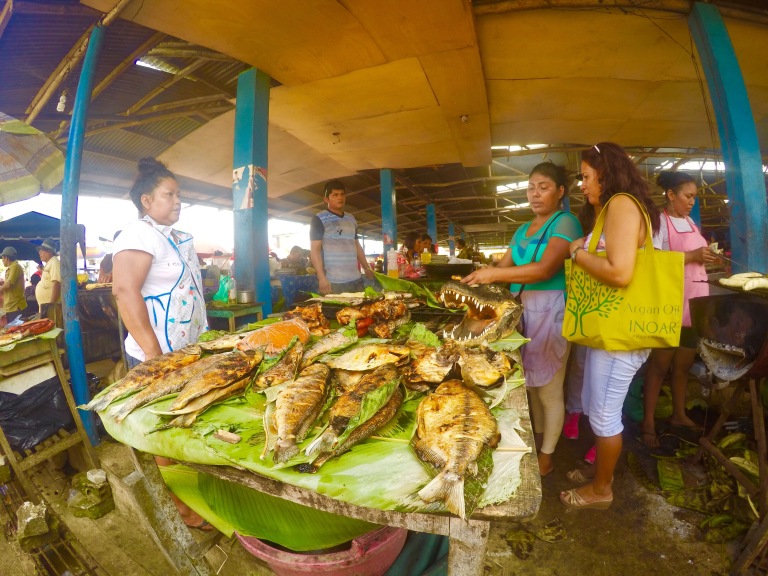
We still wanted to do a more in-depth tour of the jungle and Art had the idea to go piranha fishing. When we got back to the hostel, Art and Søren went searching for a guide and I stayed back to make the ever important pisco sours. The guys came back and said they found a guide and bartered him down to 100 soles per person. The tour was from 8-5 the next day and Marco, our guide had a lot planned.
At 8am sharp Marco came by on a tuk tuk and brought us to the bellavista port. We jumped on our own aquatic bus and sped off to a jungle resort.
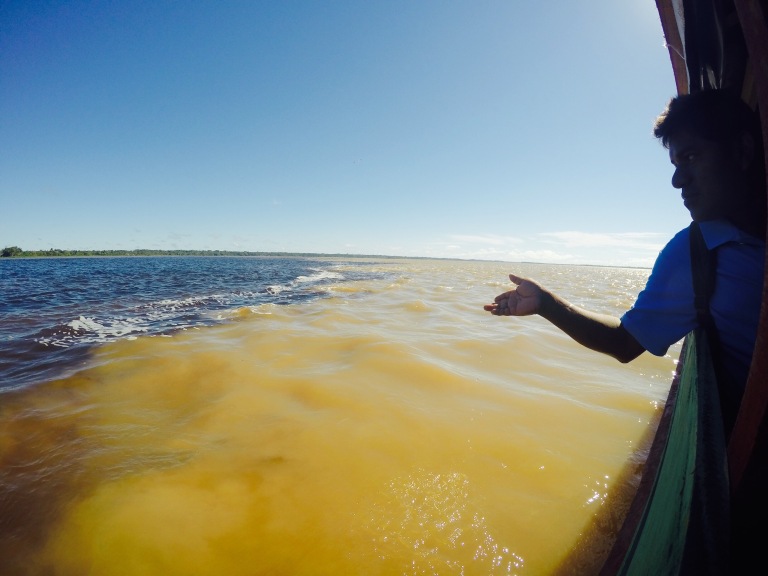
When we arrived at the little resort we were given rubber boots and bamboo rods with 6ft of fishing line and a hook on them. We hiked through some marsh then stopped at a dock/cabin that had a canoe next to it.
We pulled the canoe over and Marco jumped in and yelled back “one more!”, so Art jumped in. The canoe was sitting pretty low and I was glad to hear (or assume) there was another canoe. As I swiveled my head back and forth in search of another canoe, though, Marco yelled “one more!”, so Søren jumped in. Now I was starting to wonder, is he really expecting to fit all four? As soon as Søren sat down, I heard “one more!” Which was my unfortunate queue.
Now that all four of us were uncomfortably seated in the rickety old wooden canoe, we were within 2 inches of water level on either side. This wasn’t the least bit reassuring because: 1, we were in piranha infested waters, 2, we were using chicken as bait, and 3, there were no life vests. I asked Art what he thought and I’m pretty sure his response was “we probably won’t swamp, but we definitely could swamp”. I guess our main focus was to sit very still and avoid sudden movements.

We awkwardly paddled the canoe about 50ft from the cabin on stilts, into the mangrove trees and then Marco gave us the gold. What you do is simple, throw a big hunk of chicken on your hook, then put it in the water. Once your bait is in, slap the water furiously with the end of our bamboo rod to simulate a piranha feed.

After about 10 minutes Art got a bite and quickly pulled up a little hand-sized piranha. Not long after I got a bit and yanked up a catfish with some crazy whiskers. As I was dangling the catfish I asked how to take it off and Marco said not to touch it. “If you get spiked you get the fever” Marco quoted. Of all of the jungle danger including death by piranhas, malaria, parasites, I certainly didn’t want fever. So I passed my rod over and let the guide do the dirty work. We spent another hour fishing in the mangroves and caught just a few more small piranha, but nothing worth keeping.
As we paddled back towards the cabin, we were being taken a little sideways by the current and the back end (my end) of the canoe was being forced through some brush. As I looked at the green leaves ahead, fast approaching, I saw another nightmare. On one of the branches that was soon to collide with my face was a bright green snake, about 1/2 inch in diameter and at least 2 feet long. With less than a second to respond I yelled and ducked to the best of my ability. The canoe shook and Marco yelled, but by the time things stabled out we had passed by the branch and I was bite free.
Marco first didn’t understand what the commotion was. A minute later we explained to him there was a snake and his eyes widened a bit. I asked him if it has venom and he said “yes very venomous”. I researched it later and it was a green vine snake. They don’t often kill people but they strike at the eyes and cause blindness. Victims are suppose to get medical attention immediately, which is nice because I didn’t get bit.
Shortly after, we docked the canoe, snake-bite free and with the ability to tell people we caught piranha. We had lunch then jumped back in the aquatic bus to head for something called monkey island. This island is one of the few places that lets you play with the monkeys because they’re not bound by cages. We were told to put everything in backpacks because the little guys like to steal.
They were about as friendly as it gets and without asking jumped on our heads and started played around.

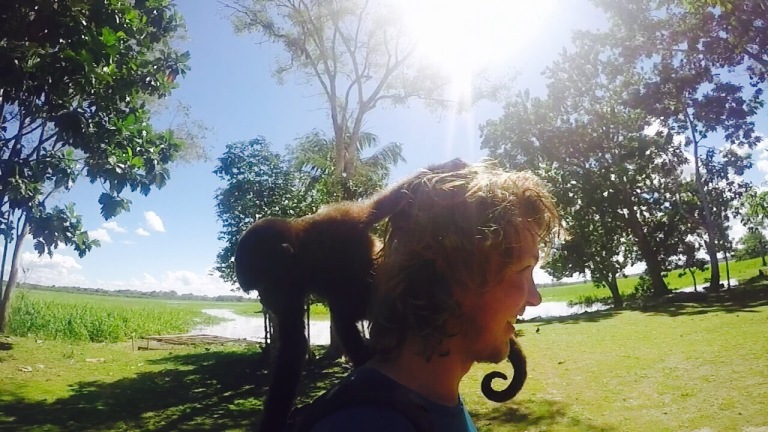
 The place also had some more toucans, parrots and sloths. We got to hangout with the monkeys for 20 minutes and the guy running the place also had a bar. We tried all the various jungle booze he had to offer, all of which were totally unique to anything we’ve had before.
The place also had some more toucans, parrots and sloths. We got to hangout with the monkeys for 20 minutes and the guy running the place also had a bar. We tried all the various jungle booze he had to offer, all of which were totally unique to anything we’ve had before.



After monkey island we had one last stop, to see river dolphins. We got to the spot where they’re commonly seen, and only waited a minute to start seeing fins. This is when Marco said we’re going swimming. I was a little hesitant because I told myself, of all things I do on this trip, that I would never swim the Amazon. But then Marco jumped in. Art and Søren were already stripping down, as well as another couple who was just hitching a ride on the boat. So we all went swimming. For around 15 minutes we treaded water and had dolphins surface around us. It definitely felt good to cool off and was worth it, but probably just for the story. This also makes me want to do the ‘recommended’ checkup with the travel doctor when I get back to the states.

We had an hour and a half ride back to bellavista port and then we split with Marco. We grabbed some more River cuisine for early dinner and then made our way back to the hostel.

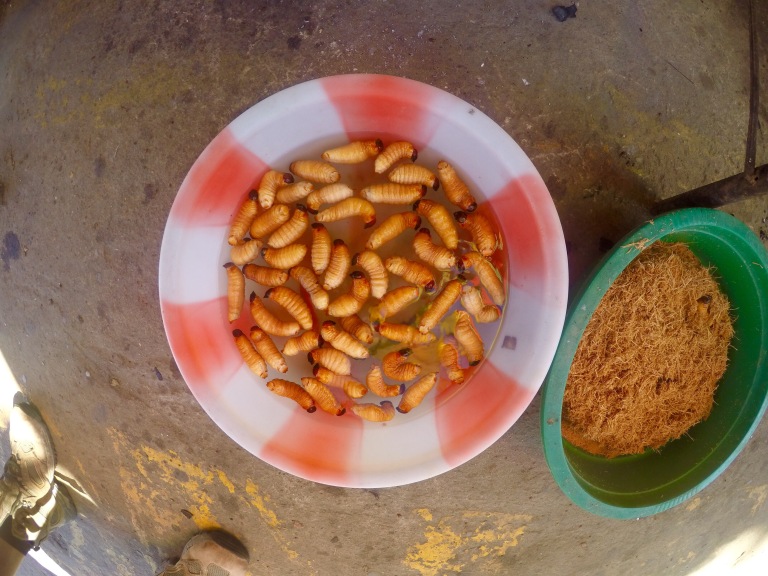
The next day Art and I began searching ways to get out of Iquitos. Our initial plan was to take a 3-day, 3-night cargo ferry east out of the Amazon. When we talked to the captain, though, the prices were higher than we expected and he wasn’t willing to barter. Then we heard of a fast boat that could get us to the same place in a day and a half. We made the decision to do this and grabbed a taxi out of Iquitos to get tickets.
The tickets were 130 soles ($40) per person and would leave from a different port named Nauta at 5:00am the next day.
In the morning we boarded and took off around 6:00am. A few hours later we stopped to drop someone off at a little village, and ladies piled onto our boat selling drinks, snacks, and rice/chicken dishes. This is pretty normal, even when buses stop on the side of the road. It’s complete chaos because everyone who was sleeping is suddenly in a state of shock as they need to find their wallets. Ladies even pull up on canoes alongside the boat to sell their stuff.

The boat kept going and it started raining as the day passed. Later in the day the boat made another stop and a bunch of village kids on a canoe infiltrated the boat from the side. They jumped in and ran up and down the aisles selling green parrots for 40 soles ($12). The captain didn’t seem to care for this and started up the boat, forcing the kids to leave by their canoe. Once we got to full speed however, we still had a squeaking parrot and a girl who must have been 15. The captain sits above the rest of the cabin and didn’t realize this. When one of the deckhands finally notified him that we were kidnapping a nice little girl, we were already five minutes downstream. This is when the captain pulled to the side of the river, slowed down just enough for the girl to jump off onto some logs, and then we sped off. The girl was left crying with her box of parrots.. We all kind of hoped her family would be around soon because it’s a big river, it was raining hard, and it got dark soon thereafter.
A few hours after dark we stopped and off loaded at a little village called Lagunas. We each got a bed in a hostel for a few hours because the river is dangerous with this size boat in the night. The next morning we loaded up at 3:30am and kept moving up the river.
Eight hours later we arrived at our destination of Yurimaguas. Here we jumped off and started looking for taxis to the town of Tarapoto, where we could get an overnight bus to the coast. But actually, the taxis found us. Being completely and utterly attacked by taxi drivers, Art and I started our aggressive technique of ignoring them. This didn’t work that good but we eventually got a low price for the 2.5 hour “taxi” to Tarapoto.
After having arrived in Tarapoto, we searched for night buses. Being totally washed out after 3 full days of travel already, we searched for a bus that would have a “bed seat” and be affordable. Unfortunately that type of accommodation was sold out and we eventually landed on a cheap, standard seat for the 15 hour bus.
Keep in mind these buses are meant for South American type of folk, and humans larger than six-foot don’t exactly fit. A box of wine usually helps this but we didn’t expect what we had coming. Six hours into our ride the bus stopped and turned off. We decided to check out the issue, and learned that there was a landslide that was closing the highway. This was unfortunately the only route to the coast and so we waited.
We waited and were told the road might be closed for two days until crew could clear it. A little frustrated, we found a beer and decided to setup hammocks rather than sleeping in our dwarf seats.

At 4:00am we heard commotion and art went to check it out. He came running back and yelling “LETS GO”. The road somehow magically cleared and our bus was leaving. After struggling with knots and throwing stuff into our packs, we managed to catch our bus.
The ride lasted much, much, much longer than planned and we finally arrived in the town of Trujillo (600km north of Lima on the coast) 28 hours after getting on the bus.
From Trujillo our destination was a 20 min cab ride to a small surf town called Huanchaco. Everything went smooth and we found a hostel with camping. After four days of traveling we finally got to drop our packs and lay down on flat ground.




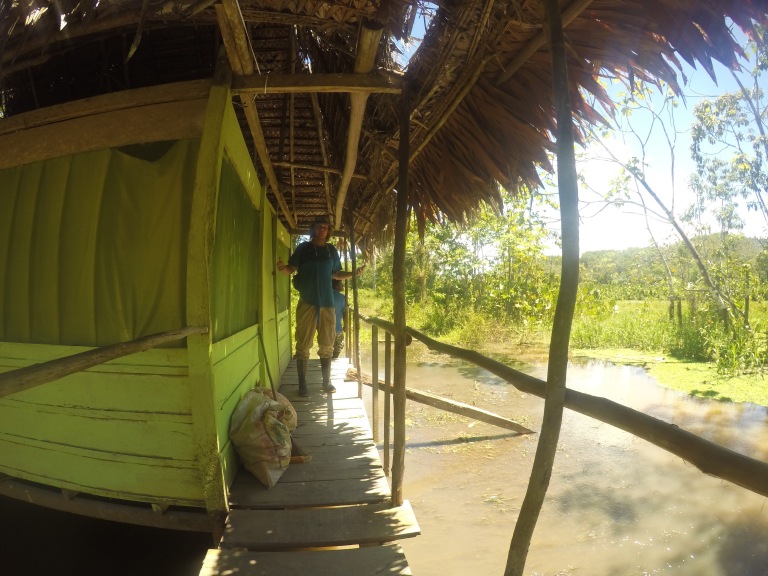
This is my favorite of all the posts you’ve done. Again, incredible. Hard to believe that you, the little guy I took for stroller rides and changed his diapers, is THIS Trevor McDonald. GREAT accomplishment. So, so proud of you!
LikeLike